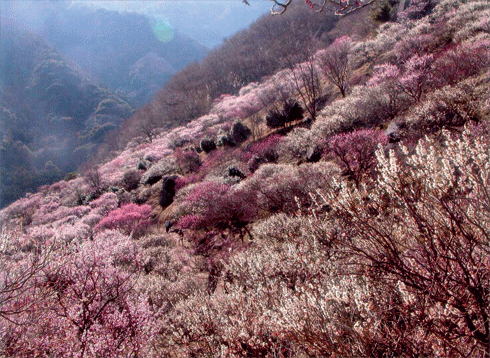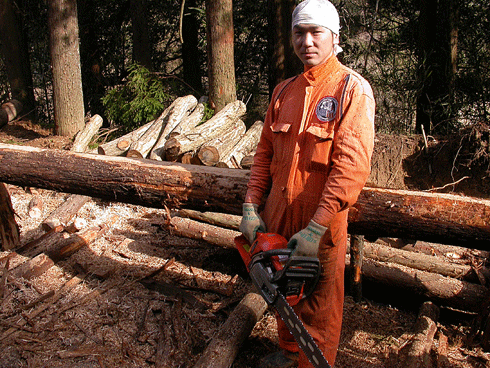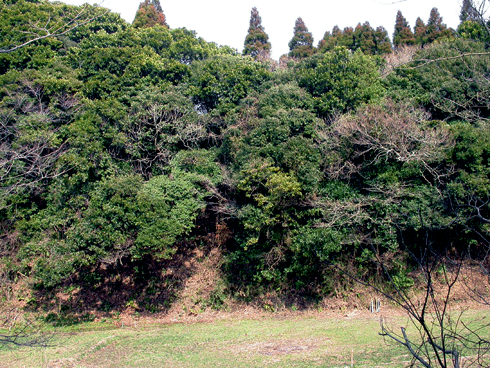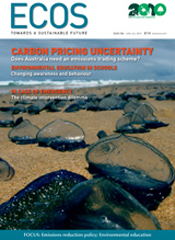
|
Published:
Nature restoration in Japan
The 10th meeting of the Conference for the Convention on Biological Diversity will be held in October 2010 in Nagoya, Japan. Jiro Kikkawa takes this opportunity to focus on the recent progress Japan has made in nature restoration.

|
|
Japanese people are once again recognising the traditional value of their environment as their natural heritage. Credit: Jiro Kikkawa
|
Japan is endowed with rich flora and fauna. The Japanese archipelago was once connected to the Asian continent, permitting the distribution of both Palaeo-arctic and Oriental biota. Then, through the long period of geographic isolation, many endemic species evolved on islands. They survived glaciation, which did not affect the region. Japan’s complex topography, with high mountains, lakes, rivers and forests ranging from subtropical islands to boreal forest, harbours approximately 100 species of mammals and 250 species of breeding birds. The country’s extensive and complex coastline of approximately 35?000 km includes beaches, mudflats, cliffs, algal and seagrass beds, and coral reefs. Much of the artificial coast containing human-made structures can be modified to restore natural habitats.
In the wake of Minamata
In 1967, the serious health hazards caused by heavy metal pollution (for example, organic mercury and cadmium) prompted new national environmental legislation. Minamata disease, for example, was officially recognised as a pollution sickness in 1956, after local people were paralysed by eating fish and shellfish caught in Minamata Bay in Kyushu. The food was contaminated by methyl mercury, which was present in effluent from a fertiliser factory and had accumulated along the food chain of the estuarine ecosystem.
The new law required that the cause of every major incident of pollution be identified, and that responsibility be assigned. Legislative standards and limits were set for every pollutant at the source of the emission and in the environment. Environmental pollution was defined as damage to human health and the living environment from pollution, or deterioration of the quality of the living environment. The definition encompassed air, water and soil pollution, noise, vibration, ground subsidence and offensive odours. However, the definition of the ‘living environment’ stopped short of including resources, and plant and animal life unrelated to humans. It included only properties located close to human settlements, and the environments in which plants and animals were closely associated with humans. The 1972 UN Conference on the Human Environment in Stockholm adopted a similarly anthropocentric definition and environmental legislation among OECD countries still reflects this bias.
Old laws governing the extraction of mineral resources and the development of associated industries were revised, so that industries could no longer depend on the cost–benefit analysis of economics alone, and technological ineptitude could no longer excuse pollution of the environment. Laws controlling the harvest of living resources, such as game and fish, were also revised to ensure environmental protection. The Environment Agency was created in 1971 (upgraded to the Ministry of the Environment in 2001) to administer this new legislation.
Post-oil shock: towards a new consensus
Unfortunately, new toxic chemicals continued to appear in the environment; for example, pesticides, polychlorinated biphenyls, vinyl chloride, dioxin and other chemicals with the potential to disturb the endocrine system of animals and people. However, in 1973, unprecedented economic growth in Japan came to an abrupt end with the onset of the oil shock, bringing greater scope for the regulatory control of development and management of resources. New legislation gave the public the right to participate in the planning of national development and large-scale public works, such as dams, began to be questioned as economic growth reached its post-oil shock peak in the 1980s.
For example, in 1988, full-scale work began on the Nagara River Estuary Barrage. Citizens’ groups and non-government organisations formed a league to oppose the dam construction, expressing public concern about its impact. The dam and the new environment would threaten anadromous fishes such as ayu (Plecoglossus altivelis), a fish closely related to salmon, cherry salmon (Oncorhynchus masou), and the freshwater bivalve (Corbicula japonica), possibly causing local extinction of these species. Accountability was demanded not only as a means of building consensus, but also to facilitate participation by the public in project planning.
Following the UN Conference on Environment and Development and the 1992 Earth Summit in Rio de Janeiro, Japan enacted the Law for the Promotion of Nature Restoration in 2002 to enable implementation of environmental restoration as the primary objective of engineering work. A new National Strategy for the Conservation of Biological Diversity was adopted; conservation and restoration of nature, and sustainable use of natural resources, became major policy directions.
Conservation from the bottom up
Under the Law for the Promotion of Nature Restoration, new projects to restore nature may be proposed and implemented by regional groups and national or regional self-governing bodies. Instead of top-down approaches, with the government planning centrally and acting unilaterally in the implementation of public works, bottom-up proposals are now encouraged. The law defines nature restoration as the ‘activity to conserve, restore, re-create, maintain and manage the natural environment by the participation of national, prefectural and municipal administrative bodies of the region involving local resident groups, non-profit organisations, specialists and other stakeholders, for the purpose of restoring damaged ecosystems and other natural environments’.
Any party intending to implement a nature restoration project must organise a Nature Restoration Council. The council must consist of initiating parties (eg resident groups, non-profit organisations and landholders) and others intending to participate in the project, together with local governments and the relevant administrative authorities of the national government. The council is required to prepare the general framework for nature restoration, discuss the implementation plan and be responsible for communication and networking throughout the implementation of the project. Between 2003 and 2006, 19 Nature Restoration Councils have been established nationwide, aiming to restore natural environments such as wetlands, grassland, lowland forests and marine ecosystems.

|
|
Japanese cranes (Grus japonensis) are a vulnerable species and are designated as a Special Natural Monument species under the Heritage Preservation Act. Credit: Jiro Kikkawa
|
Rivers and primary industries
Fifty-one per cent of Japan’s approximately 130 million inhabitants, and 75 per cent of their assets, are concentrated in roughly 10 per cent of the country’s total land area. All this land area is prone to flooding, and the agricultural system is centred on rice growing, which requires water supply throughout the growing season. Dams and canals have been built since the seventh century for flood mitigation, erosion control and irrigation; today, Japan has more than 210?000 dams, including farm dams. By 2000, of those dams with a height of 15?metres or more, 56.5 per cent were for irrigation, 14.2 per cent for hydroelectric power generation and 21.3 per cent were multi-purpose (including flood control).
Dam construction interrupts migratory fish movements and fragments terrestrial habitats. It also causes loss of the stream environment in watershed areas, and reduces flow rate and sediment supply downstream. Since 1997, with the adoption of a legislative framework for the conservation of the river environment, near-natural river restoration has been adopted as a policy goal. The aim is to maintain rivers in harmony with local lifestyle, history and culture, and to restore the original environment for local flora and fauna, as well as the landscape, as much as possible.
Fishways and water’s edge biotopes have been built to recover some lost aquatic life. For example, when a fishway was built in the water’s edge biotope of Osone Wetland in Saitama Prefecture in 2001, pond water was connected to the nearby Ayase River, permitting the movement of fish. As a result, the field gudgeon (Gnathopogon elongatus) and brackish goby (Acanthogobius flavimanus)
returned to the wetland. Volunteer assistance in the monitoring and adaptive management of the biotope has helped stands of native sugarcane reeds (Miscanthus saccchariflorus) to expand,
and invasive golden rods (Solidago altissima) to disappear.
Since 1999, legislation addressing sustainability, conservation and restoration in the areas of agriculture, rural communities, forestry and the marine environment has been adopted. Some endangered species, such as the Iriomote cat (Felis iriomotensis), Japanese crane (Grus japonensis) and giant salamander (Andrias japonicus) have been designated as iconic species (‘Special Natural Monuments’), deserving of absolute protection. Recent efforts to establish wild populations of the once locally extinct oriental stork (Ciconia boyciana) and crested ibis (Nipponia nippon) have been successful. In response to the serious impacts of spreading exotic species, the Invasive Alien Species Act was enacted in 2005 to control the handling of imported plants and animals.
In cities and parks
Since 2006, the protection of biological diversity has extended to urban green space. Plans for public works for new roads, flood mitigation, sewerage, city parks, ports, harbours and airports must combine social capital improvement with nature restoration.
Japan has 28 national parks, 55 quasi-national parks and 308 prefectural natural parks, altogether occupying about 14 per cent of the total land area. In addition, there are 84 marine parks among the national and quasi-national parks. Natural parks play an important role as the place of contact with nature through outdoor experiences, such as nature observation and recreation, along with the conservation of natural communities.
Professional and volunteer efforts
The Ecology and Civil Engineering Society was founded in 1997 to develop a new interdisciplinary field – applied ecological engineering. Post-implementation monitoring is now accepted as a necessary part of evaluating the success of ecological engineering projects. Valuable case histories of many such projects are included in The Restoration of Nature in Japan: A Challenge to Ecological Engineering (third edition), edited by Toshio Hirose, one of the founders of the society.

|
|
Volunteers are building a wild boar fence along an irrigation channel near a paddy field as part of the restoration. Credit: Jiro Kikkawa
|
The role of non-profit organisations in nature restoration work is also significant in the context of a recent shift among young people towards rural lifestyles. Many young tradesmen tired of urban life are moving to the country looking for a life that is more connected with nature. Traditional rural Japanese landscapes of rice paddies and satoyama (managed woods for charcoal production and non-wood produce, now untended), though very much modified, are considered ‘natural’; many city dwellers dream of living in such scenes. There is now a definite trend among some of these people to move to rural settings, where they readily volunteer for nature restoration work.
More effort is needed to build consensus among Japanese people regarding the goals of nature restoration. Partnerships should be formed among stakeholders for projects, and efforts should be made for capacity building and skill development among volunteers and managers of Japan’s natural ecosystems.
More information
Hirose, T (ed.) (2010). The Restoration of Nature in Japan: A Challenge to Ecological Engineering. (3rd ed) Tokai University Press, Tokyo.
Osugi, T, Tate, S, Takemura, K, Watanabe, W, Ogura, N and Kikkawa, J (2007). Ecological research for the restoration and management of rivers and reservoirs in Japan. Landscape and Ecological Engineering 3, 159–170.




